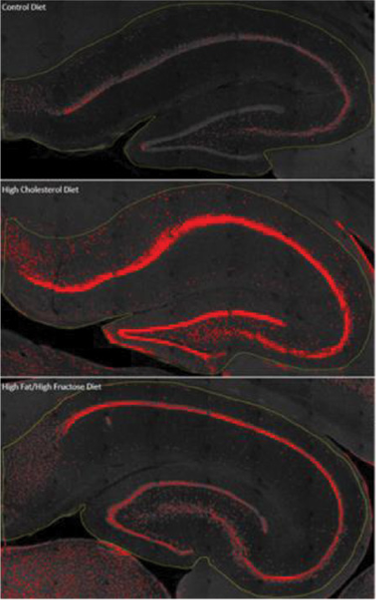Key Points:
- Old rabbits fed a high-cholesterol or high-fructose diet display impaired memory.
- A high-cholesterol or high-fructose diet reduces brain connectivity in older rabbits.
- The buildup of Alzheimer’s-associated protein beta-amyloid is elevated by a high-cholesterol or high-fructose diet.
Alzheimer’s disease still has no real cure, making prevention a priority. Now, scientists from Northwestern University provide evidence suggesting that we could slow down the deterioration of our brain, potentially preventing Alzheimer’s dementia through dietary intervention.
Published in Alzheimer’s & Dementia: Translational Research & Clinical Interventions, Weiss and colleagues induce major features of Alzheimer’s disease in aged rabbits by feeding them specific foods. A diet high in cholesterol or fructose and saturated fat impairs the memory of the rabbits while reducing their brain connectivity and increasing the level of a protein called beta-amyloid. These findings suggest that making the wrong dietary choices could lead to dementia.
High-Cholesterol and High-Fructose Diets Induce Memory Loss and Brain Pathology
Late-onset Alzheimer’s disease (LOAD) — with symptoms beginning after the age of 60 — accounts for over 90% of Alzheimer’s disease cases. Considering that LOAD risk factors include age, high cholesterol, and type 2 diabetes, Weiss and colleagues fed older rabbits (~30 months old) a diet high in cholesterol (2% cholesterol), or a diabetes-inducing diet with high levels of saturated fat and fructose (10% saturated fat from coconut oil and 30% fructose).
To test whether the high-cholesterol or high-fructose diet could recapitulate aspects of LOAD, the researchers assessed memory (loss of memory is a hallmark symptom of LOAD). Older rabbits were placed with objects of different shapes, then, the objects were replaced with newly shaped objects. It was found that both high-cholesterol and high-fructose diets led to the rabbits spending less time exploring new shapes over old shapes, suggesting impairments in spatial memory.

Each region of our brain, with its own particular function, is connected to other regions to form an elaborate network. Based on MRI scans, LOAD patients have been found to exhibit differences in brain network connectivity that may contribute to cognitive deficits like memory loss. Likewise, Weiss and colleagues found brain connectivity to be reduced in older rabbits fed a high-fructose or high-cholesterol diet. Along with spatial memory loss, these findings further suggest that high-cholesterol or high-fructose diets can contribute to triggering LOAD.

The primary brain region associated with memory consolidation is the hippocampus. The degeneration of the hippocampus, which occurs with LOAD, is associated with memory loss. Furthermore, the accumulation of a protein called beta-amyloid is linked to the degeneration of the hippocampus and other brain regions in LOAD and other forms of dementia. Weiss and colleagues found that amyloid was elevated in the hippocampus of rabbits fed either the high-cholesterol or high-fructose diet, indicating that these diets may induce Alzheimer’s-like brain pathology.

The findings of Weiss and colleagues show that an Alzheimer’s-like syndrome, encompassing memory loss, reduced brain connectivity, and amyloid-beta buildup, can be triggered in elderly rabbits by feeding them a diet containing high levels of cholesterol or saturated fat and fructose. If translatable to humans, this implies that what we eat is important for keeping our brains healthy as we age.
High Fructose Consumption Linked to Increased Risks of Alzheimer’s in Humans
Fructose — a type of sugar found in fruit and many processed foods in the form of high-fructose corn syrup — could lead to Alzheimer’s disease late in life. This is supported by the findings of Weiss and colleagues as well as a recent human study showing an association between fructose consumption and the increased prevalence of dementia and Alzheimer’s disease in middle-aged adults.
Interestingly, studies like these have led scientists to hypothesize that Alzheimer’s is an evolutionary maladaptation mediated by brain fructose metabolism. The hypothesis is based on how brain regions not essential for survival are shut down by fructose. These brain regions include those associated with memory and contemplation, which are shut down in Alzheimer’s. Reducing activity in these regions may have been advantageous for our starving ancestors to find food, but chronically reducing this activity (via high fructose consumption) may contribute to the high prevalence of Alzheimer’s we see today.
“We believe that initially the fructose-dependent reduction in cerebral metabolism in these regions was reversible and meant to be beneficial,” said Dr. Richard J. Johnson of Colorado University, a proponent of the fructose maladaptation hypothesis. “But chronic and persistent reduction in cerebral metabolism driven by recurrent fructose metabolism leads to progressive brain atrophy and neuron loss with all of the features of Alzheimer’s disease.”